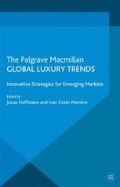Abstract
China’s luxury goods market will be worth an estimated US$ 27 billion by 2015, representing 20 percent of global luxury sales.1 As observed in other sectors in China, the speed at which the market took off is impressive. Louis Vuitton entered the market 20 years ago, has currently more than 40 stores in China and is opening more at a fast pace.2 No surprise that (Western) luxury groups are in great shape, reporting double-digit growth and profits. This market big bang has been a bonanza for Western luxury conglomerates and companies and their commercial partners in Hong Kong and mainland China. Strong growth and high profit margins have of course attracted newcomers, but no local brand exists so far to challenge the likes of Louis Vuitton, Hermès, Gucci or Prada in China, and even less abroad. Given China’s economicgrowth, rich craftsmanship tradition and growing availability of financial and managerial competences, there are grounds for such a development.
Access this chapter
Tax calculation will be finalised at checkout
Purchases are for personal use only
Preview
Unable to display preview. Download preview PDF.
NOTES
McKinsey & Company (2011), Understanding China’s Growing Love for Luxury.
Moingeon, B. and Lehmann-Ortega, L. (2010), “Creation and Implementation of a New Business Model: A Disarming Case Study”, M@n@gement, 13(4): 266–297
Hoffmann, J. and Hoffmann, B. (2012), “The PIER Framework of Luxury Innovation”, in Hoffmann, J. and Coste-Manière, I. (eds), Luxury Strategy in Action, London: Palgrave Macmillan.
Chesbrough, H. and Rosenbloom, R. S. (2002), “The Role of the Business Model in Capturing Value from Innovation: Evidence from Xerox Corporation’s Technology Spinoff Companies”, Industrial and Corporate Change, 11(3): 529–555.
Birindelli, F. G. (2012), “Luxury Business: Multinational Organizations and Global Specializations”, in Hoffmann, J. and Coste- Maniére, I. (eds), Luxury Strategy in Action, London: Palgrave Macmillan.
Quintavalle, A. (2012), “Retailing in the Luxury Industry”, Hoffmann, J. and Coste-Manière, I. (eds), Luxury Strategy in Action, London: Palgrave Macmillan, pp. 74–107.
Pizzini, G. (2012),“Financial Survival Guide: Value Creation and Piña Coladas”, Hoffmann, J. and Coste Maniére, I. (eds), Luxury Strategy in Action,London: Palgrave Macmillan.
Editor information
Editors and Affiliations
Copyright information
© 2013 Jonas Hoffmann and Betina Hoffmann
About this chapter
Cite this chapter
Hoffmann, J., Hoffmann, B. (2013). Paths For The Emergence Of Global Chinese Luxury Brands. In: Hoffmann, J., Coste-Manière, I. (eds) Global Luxury Trends. Palgrave Macmillan, London. https://doi.org/10.1057/9781137287397_3
Download citation
DOI: https://doi.org/10.1057/9781137287397_3
Publisher Name: Palgrave Macmillan, London
Print ISBN: 978-1-349-44968-2
Online ISBN: 978-1-137-28739-7
eBook Packages: Palgrave Business & Management CollectionBusiness and Management (R0)

